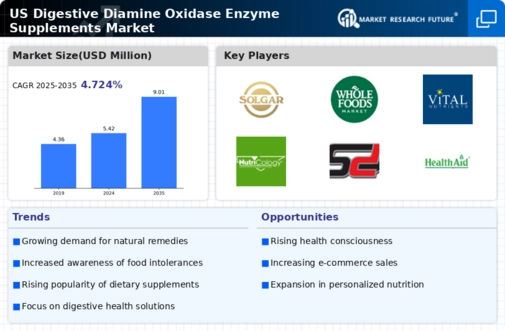Increased Focus on Gut Health
The heightened focus on gut health among consumers is a pivotal driver for the digestive diamine-oxidase-enzyme-supplements market. As research continues to unveil the critical role of gut health in overall well-being, consumers are becoming more aware of the importance of digestive enzymes. This awareness is reflected in the growing number of products marketed specifically for digestive health, with the gut health supplement market projected to reach $10 billion by 2027. The emphasis on gut health may lead to increased interest in supplements that support enzyme production, including diamine oxidase. Consequently, manufacturers may find opportunities to innovate and create specialized products that cater to this burgeoning consumer interest.
Expansion of E-commerce Platforms
The rapid expansion of e-commerce platforms is reshaping the landscape of the digestive diamine-oxidase-enzyme-supplements market. With the convenience of online shopping, consumers are increasingly turning to digital channels to purchase health supplements. This shift is evidenced by the fact that online sales of dietary supplements in the US have seen a substantial increase, accounting for nearly 30% of total sales in recent years. E-commerce not only provides consumers with a wider selection of products but also facilitates access to detailed product information and customer reviews. As a result, manufacturers and retailers may need to enhance their online presence and marketing strategies to capitalize on this trend, potentially driving further growth in the market.
Shift Towards Preventive Healthcare
The ongoing shift towards preventive healthcare is significantly influencing the digestive diamine-oxidase-enzyme-supplements market. Consumers are increasingly prioritizing health maintenance over reactive treatments, leading to a surge in demand for dietary supplements that promote digestive health. This trend is reflected in market data, which shows that the dietary supplement industry in the US is projected to reach approximately $50 billion by 2026. As individuals become more proactive about their health, the interest in supplements that support digestive enzymes, particularly diamine oxidase, is likely to grow. This shift may encourage manufacturers to develop targeted marketing strategies that emphasize the preventive benefits of their products, potentially expanding their market reach.
Rising Popularity of Natural Ingredients
The growing consumer preference for natural and organic products is a significant driver for the digestive diamine-oxidase-enzyme-supplements market. As consumers become more health-conscious, they are increasingly seeking supplements that contain natural ingredients without artificial additives. This trend aligns with the broader movement towards clean label products, where transparency in ingredient sourcing is paramount. Market Research Future indicates that the natural supplements segment is expected to witness a CAGR of around 8% through the next few years. Consequently, manufacturers may need to adapt their formulations to meet these consumer demands, potentially leading to an increase in the availability of high-quality, natural digestive supplements.
Increasing Incidence of Food Intolerances
The rising prevalence of food intolerances, particularly histamine intolerance, is a notable driver for the digestive diamine-oxidase-enzyme-supplements market. As more individuals experience adverse reactions to histamine-rich foods, the demand for supplements that aid in digestion and histamine breakdown is likely to increase. Reports indicate that approximately 1% to 3% of the population may suffer from histamine intolerance, leading to a growing consumer base seeking solutions. This trend suggests that manufacturers may need to innovate and expand their product lines to cater to this specific demographic, thereby enhancing market growth. Furthermore, educational campaigns about food intolerances could further elevate awareness and consumption of these supplements, indicating a potential upward trajectory for the industry.























Leave a Comment